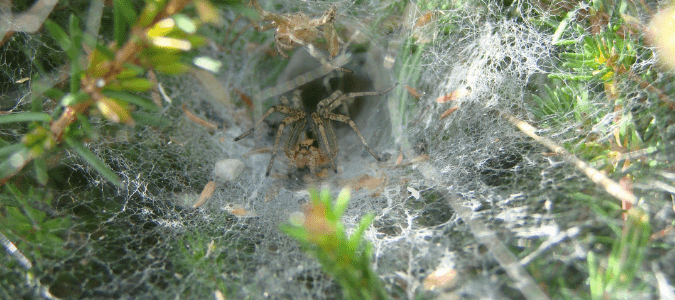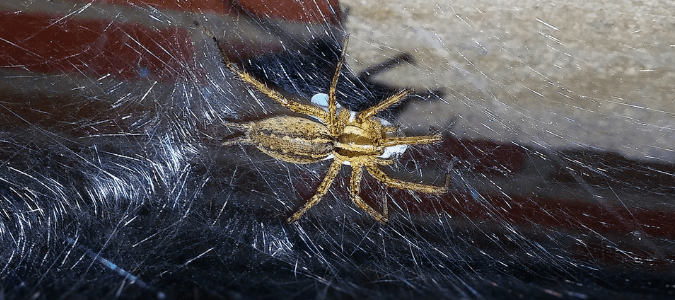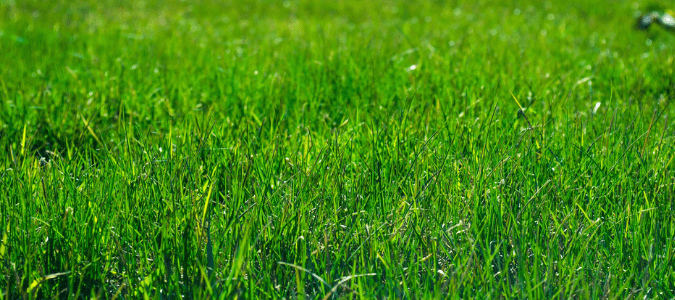
Most of us who live here in the Lone Star State are familiar with the saying “Everything’s bigger in Texas”. When it comes to our size and our state pride, that’s usually a good thing. In some other situations, however, this phrase can extend to other topics which can easily evoke feelings of pure terror. Depending on your level of comfort with these eight-legged creatures, grass spiders in Texas could certainly fit into this category.
Why is that, exactly? There are probably several reasons many homeowners are frightened of any spiders they may run across on their property. First of all, there two types of Texas spiders that are venomous: the black widow and the brown recluse. While neither of these species is aggressive, and the risk of getting bitten is low, most of us can’t quickly identify whether what we saw in our grass or our closet was dangerous or not, so irrational fears of an unfortunate encounter leading to a medical emergency can easily take hold. Then, there are many spider myths that perpetuate which make these creatures seem even more mysterious and scary than they may appear. Last, but certainly not least, when it comes to species like the jumping spider, Texas residents are justified in steering clear of any creatures that move quickly, or even varieties like the tarantula, which can be quite large.
If you are concerned about spiders and the dangers they may pose to you and your loved ones, then it’s a good idea to learn all that you can about grass spider webs, grass spider bites, what to do when grass spiders are in a house and if grass spiders are poisonous. We’ll cover all that and more in this blog post. First, we’ll explain what grass spiders are and what they look like.
As you might expect, grass spiders live in tall grass, heavy ground cover and on the branches of thick shrubs. What most of us simply refer to as “grass spiders” are often actually funnel weaver spiders. Females in the family Agelenidae can be anywhere from about a half inch to three-quarters of an inch, and males are a bit smaller in size. These arachnids are usually yellowish-brown, with two black stripes running longitudinally, while their abdomens are covered by a series of chevrons—one way to tell grass spiders from wolf spiders. While these spiders are often found in grass, they can also build webs in mulch, in cracks along rocks and in and around boards.
These critters only stay alive for about a year. Grass spiders are equipped with remarkable speed that enables them to catch their insect prey with ease before dragging the victim into the funnel of their web. In case you were wondering, grass spiders pose little to no threat to your grass or plants.
Most of the reproductive phase takes place over winter when the female lays egg sacs that develop into spiderlings in the spring. If you are trying to spot an egg sac, look carefully towards the edge of the web. Once the eggs hatch, the hatchlings will move on and begin building their own individual nests.
Grass spiders are not the only variety of arachnids that prefers the great outdoors. Other common species are the jumping spiders, orb weavers and the wolf spider.
Jumping spiders are small, but can give Texans quite a scare, as they can launch themselves a distance of up to 25 times their size. This hopping trait helps these spiders attack unsuspecting prey, and makes webs unnecessary. A jumping spider’s coloration is dull; however, the males may shimmer. Jumping spiders also have eight eyes, four of which are located on the face while the others are attached to the highest point of the carapace. Jumping spiders are venomous, but their poison is harmless to humans. A bite causes mild, slightly localized pain, itching and mild sweating.
If you didn’t see a funnel weaver or a jumping spider in your grass, you may have spotted an orb weaver. These spiders come in a variety of colors, shapes and sizes, which can make it difficult to correctly identify them in your backyard. A common feature is their rounded abdomen and orange-to-brown or brown-to-black coloring. The orb weaver’s body tends to be an elongated shape, while the size can range from a quarter-inch for males and to three-quarters of an inch for females.
You may see an orb weaver in tall grass, near any corners along the exterior of a living structure and under protected porches. When seeking prey, orb weavers will sit in the middle of their elaborate webs, with their head facing downwards, for an unsuspecting victim. Orb weavers are nighttime hunters and have a palate that enjoys insects, including mosquitoes. If an orb weaver has bitten you, don’t panic. These spiders are not dangerous to humans, although you may experience pain, slight swelling and redness after being bitten.
The most scary-looking arachnids you may run across are wolf spiders. These critters are big, hairy and hunt at night while seeking solace in sheltered spaces during the day. Wolf spiders are quick movers with keen eyesight. Unlike orb or funnel weavers, wolf spiders don’t rely on a web to catch their prey. As their name might suggest, these spiders chase and pounce on their potential meal like cheetahs or wolves. Similar to jumping spiders, wolf spiders have eight eyes. Their dark, mottled coloration makes it easy for them to blend in with their ideal habitat, which might be in and around decaying plant matter or dirt. Occasionally, wolf spiders will seek shelter in holes under rocks or logs. Bites from a wolf spider are rarely considered dangerous and don’t usually require treatment. Symptoms include an itchy or sore red mark around the affected area. Seek medical attention if you or a loved one notice considerable swelling, itchiness, blistering, a rash around the bite or breathing problems.

What Does A Grass Spider Web Look Like?
One of the most incredible things about grass spiders is their ability to weave distinctive webs. A grass spider web is funnel-shaped and sits near the ground, making it easy for prey to become trapped. While these webs lack a traditionally sticky texture, the funnel shape makes it extremely difficult for the prey to escape. Once a spider’s prey is stuck, the grass spider immediately transitions into attack mode. After crawling over, the arachnid injects its victim with venom. As a bonus, the grass spider web’s horizontal, sheet-like orientation provides these creatures with a vantage point to spy on prey from afar.
If you see a spider in your backyard on a funnel-shaped web or hanging out close to one, then you know you’ve got a grass spider and not a wolf spider or jumping spider.

Will A Grass Spider Bite?
All spiders have venom. That said, most spider poison will not harm people; it’s only strong enough to slow down and paralyze an arachnid’s next meal.
Grass spider bites are highly uncommon, because a grass spider is unlikely to bite. Grass spiders do not have a venom that’s poisonous to humans; however, if you do notice what you think may be a spider bite after you come in from outside, it could be from a wolf spider, especially if the bite is painful for a while.
To treat a wolf spider bite, or any spider bite for that matter, gently clean the affected area with warm soap and water. To prevent infection, place a bandage over the wound until the itchy and uncomfortable symptoms fade.

Grass Spiders In A House: What To Do
Because grass spiders prefer to live outside, it’s unlikely you will find these types of spiders inside your home. If that ever were to happen, the good news is that these types of spiders will typically only live for a day or two. Another thing many homeowners are relieved to hear is that grass spiders cannot reproduce inside, so you will never have a grass spider infestation indoors.
Even though these creatures won’t survive for very long in a home, most of us like to take proactive measures to keep all types of spiders in their natural habitat and away from ours. One way to do so is to seal any cracks, gaps and other openings that could provide any type of pest with an entry point. Next, you may consider inspecting and making any needed repairs around windows and doors so they fit snugly. Reduce household clutter, which insects and other animals may use for shelter and to breed, including cardboard boxes and stacks of paper. Trim back the foliage on shrubs or vines and relocate any firewood from stacks that might be next to your foundation. Also, take the time to remove any leaf litter, sticks or other yard debris near the house.

Are Grass Spiders Poisonous?
Ready for some good news about these creatures? No, grass spiders are not poisonous. These creatures are low-risk, non-aggressive arachnids whose venom is weak enough to be virtually harmless to humans. What does a spider bite look like? In a vast majority of cases, the impacted area will look very much like an insect bite. You may notice a bump, which could get red, itchy or swollen. You usually won’t feel any pain any worse than a bee sting, and if you do, the discomfort should only last for about an hour.
Whether you have been bitten by a poisonous spider or another type, the treatment is the same. You’ll want to first clean the affected area with soap and water. Apply antibiotic cream. Then, apply a cool washcloth, a cold compress or ice bag to the bite. Elevate your arm or leg, if you were bitten there. Ibuprofen or acetaminophen should help with pain and antihistamine can ease swelling.
If you experience cramps, have more immediate severe symptoms, develop an open sore or a bullseye-shaped mark or if the bite worsens after 24 hours, see a medical professional immediately. Some other warning signs are a worsening of discomfort around the bite site, a larger area on your skin that’s become red or irritated or any type of liquid draining from the bite.
ABC Can Protect Your Home From Grass Spiders
The grassy terrain of many Texas backyards, especially those found in the northern regions of the state, make it easy for grass spiders to eat, live and reproduce comfortably without you ever seeing them. Let ABC & Commercial Services use their expertise to help you locate these insects from in and around your lawn. Our skilled technicians have the knowledge needed to properly treat these bugs with insecticides or natural removal processes so that your home remains free from these pests.
